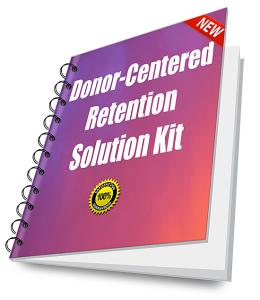 People are unpredictable sometimes. They’re also predictable.
People are unpredictable sometimes. They’re also predictable.
If you see someone yawn, you’re likely to yawn too.
If I tell you seats are limited, you’re likely to purchase a ticket now rather than later.
What if you knew getting people to donate to your nonprofit could be a predictable consequence of something you did?
It turns out you can encourage people to act in desirable ways, simply by applying a few lessons learned from neuroscience, psychology and behavioral economics. The truth is scientists have learned quite a lot over the past few decades. It’s up to us to put that learning to good use!
Alas, as Daniel Pink, author of To Sell Is Human, has noted: “There’s a gap between what science knows and what business does.” This applies to social sector businesses too!
That’s right. Pink explains the most successful for-profit businesses use what science knows to “convert leads to customers.” The secret to more sales is knowing what the customer wants. Your non-profit might convert prospects into donors, and donors into repeat donors, using the very same principle.
The secret to closing more gifts is knowing what the donor wants.
Today I’d like to consider five specific strategies that will help you ethically take advantage of some of the psychology underlying human behavior. Once you understand these principles, you can begin to strategically apply them to your integrated development (marketing and fundraising) strategy. If you’re nervous about this, you can test what you did before against a new strategy informed by science. Break your mailing list randomly in half, send an “A” and a “B” version of your appeal, and see which performs best.
Ready for 5 science-informed strategies?
1. Help Customers Break Through Action Paralysis by Setting Minimums.
Research by Robert Cialdini, author of Influence: The Psychology of Persuasion (a book from which I frequently draw inspiration), showed how the American Cancer Society increased donations by 78% simply by suggesting minimums.
ACTION: One way to set a minimum is simply to ask for a specific gift. Rather than a vague “your gift helps” or “your gift of whatever size helps” you can try “Will you consider a gift of $25?” You might want to randomly divide your list in half and test the success of the vague ask against the minimum ask to see what works best for you.
ACTION: Another way to set a minimum is to suggest minimal parameters. In Cialdini’s study, 50% of door-to-door solicitors asked “Would you consider a donation?” The other half of the solicitors added the sentence “Every penny will help?” The added sentence increased donations two-fold. Why? The conclusion was that too often folks think their gift will be too small to make a difference. When they learn this is not the case, they feel free to give.
ACTION: The other way is to break down your ask to the lowest common denominator and ask for that. You’ve seen this approach: “For just 60 cents a day you can save a child’s life.” It’s easier for folks to visualize spending 60 cents to help than it is $219; the latter ask will paralyze them. And by the way, giving too many choices will also paralyze folks. It’s called “analysis paralysis ” or the “paradox of choice.”
2. Embrace the Power of Labels
Who doesn’t want to be called a “Leader,” “Founder,” “Inner Circle Member” or something of that nature? One behavioral study of voting patterns found that people randomly labeled “politically active” were 15% more likely to vote. In other words, folks rise to the occasion – they act as they are labelled! Labels may be used to your benefit in a number of ways.
ACTION: One way is to address folks by their affiliation with your organization, using a flattering adjective. Try calling a prospective donor by something with which they identify (e.g., “Dedicated alumna” or “Justice Enabler”).
ACTION: Another way is to invite folks to join an elite group. Most humans are wired for community and long for affiliations with like-minded folk. For example, invite them to join your “Monthly Giving Club” or “Inner Circle Givers” society. If you ask folks specifically to become “insiders” they’re more apt to do so than if you simply wait for them to label themselves that way.
3. Understand the 3 Types of Buyers
Research breaks buying behavior into three types: (1) Spendthrifts (15%); (2) Tightwads (24%), and (3) Unconflicted (Average) Spenders (61%). You’ll likely find donors fall into three categories as well.
ACTION: Run a report from your database to get a breakdown and see how your percentages compare for (1) Major Donors; (2) Smaller Donors (this might be under $100 or under $25, depending on your number of donors and average gift), and (3) Average Donors (for many small to medium-sized nonprofits this may be folks who give between $100 and $999). While these categories won’t align 100% with the Spendthrift – Tightwad model (“Homeless Hal’s” $25 gift may truly characterize him as a spendthrift), using these categories may, as they say, be “close enough for government work.” [If you’re large enough to dig deeper, you might consider sending donors a survey to help ascertain what motivates their economic behavior.]
ACTION: You will want to have a different fundraising approach for each donor type. For “spendthrifts” you want to develop a major donor program with a series of “moves” you manage to assure you make the optimum match between your donors’ interests and passions and your organization’s programs and values [for more on how to do this, get my 50 Ways To Move Your Donors Relationship-Building Solution Kit]. For smaller donors who may be spendthrifts or tightwads you may want to reframe giving opportunities into “bundles” (e.g. $10/month instead of $120/year) in order to boost their giving. For average givers you may wish to consider the strategy discussed in #2, above, and consider inviting them to join one of your “Giving Societies” – thereby upgrading their level of giving.
4. Highlight Strengths by Admitting Shortcomings
Research shows when you embrace your errors folks are more likely not only to forgive you, but also to trust you. And guess what? This holds true even if the fault lies outside your organization! So it’s a good idea to take responsibility whenever something fails to live up to expectations, whether you were in control of what happened or not.
ACTION: A positive way to embrace errors is to discuss the creative solutions you’re considering rather than the problem. Let’s say your organization gets a bomb threat. Rather than dwell on the lack of security, impress your constituency with the steps you’re taking now to ensure everyone’s safety. What if the homeless shelter you promised to build with your donors’ gifts is behind schedule? Rather than blame the contractor, let folks know what you’re doing now to help the homeless women you’ll ultimately support in your new shelter. In other words, put the past behind you and move forward with confidence and humility.
5. Use Urgency the Smart Way
Urgency and scarcity will drive sales (and donations). But not unless your audience believes you.
ACTION: Make sure you describe why the situation is urgent. Specifically, why does your donor need to give now? Perhaps you have a challenge grant and they can double their money. Perhaps it’s winter and homeless people risk freezing if you don’t get them off the streets. Perhaps it’s the end of the calendar year, and this is their opportunity to grab a tax deduction. Perhaps your Gala event is filling up, and this is their last chance to buy tickets.
Before you go, I hope you’ll make a note of how helpful an understanding of some basic psychological and behavioral neuroscience principles can be to the effective practice of fundraising.
Now that you know this information, what will you do to close the gap?
Learn How to Give Donors More of What They Need
 Get the Donor Retention and Gratitude Playbook with 6 separate companion guides (at a bargain if you buy the bundle)! Or you can purchase them individually. Taken together, they are a complete Donor Retention ‘Bible’ — everything you need to raise more money by keeping your current donors and increasing their average gift! It’s filled with hands-on, practical information garnered from my 30+ years working in the nonprofit trenches. This stuff works!
Get the Donor Retention and Gratitude Playbook with 6 separate companion guides (at a bargain if you buy the bundle)! Or you can purchase them individually. Taken together, they are a complete Donor Retention ‘Bible’ — everything you need to raise more money by keeping your current donors and increasing their average gift! It’s filled with hands-on, practical information garnered from my 30+ years working in the nonprofit trenches. This stuff works!
People love this Playbook, and I promise you’ll be happy. And, like all Clairification products, this comes with a 30-day, no-questions-asked, 100% refund guarantee. You can’t lose.
Photo by Melissa Askew on Unsplash





